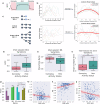Critical dynamics arise during structured information presentation within embodied in vitro neuronal networks
- PMID: 37648737
- PMCID: PMC10469171
- DOI: 10.1038/s41467-023-41020-3
Critical dynamics arise during structured information presentation within embodied in vitro neuronal networks
Abstract
Understanding how brains process information is an incredibly difficult task. Amongst the metrics characterising information processing in the brain, observations of dynamic near-critical states have generated significant interest. However, theoretical and experimental limitations associated with human and animal models have precluded a definite answer about when and why neural criticality arises with links from attention, to cognition, and even to consciousness. To explore this topic, we used an in vitro neural network of cortical neurons that was trained to play a simplified game of 'Pong' to demonstrate Synthetic Biological Intelligence (SBI). We demonstrate that critical dynamics emerge when neural networks receive task-related structured sensory input, reorganizing the system to a near-critical state. Additionally, better task performance correlated with proximity to critical dynamics. However, criticality alone is insufficient for a neuronal network to demonstrate learning in the absence of additional information regarding the consequences of previous actions. These findings offer compelling support that neural criticality arises as a base feature of incoming structured information processing without the need for higher order cognition.
© 2023. Springer Nature Limited.
Conflict of interest statement
B.J.K. and F.H. are employees of Cortical Labs. B.J.K. is a shareholder of Cortical Labs and holds an interest in patents related to the use of criticality in neural cell cultures as a metric of interest. The remaining authors declare no competing interests.
Figures





Similar articles
-
Structural Modularity Tunes Mesoscale Criticality in Biological Neuronal Networks.J Neurosci. 2023 Apr 5;43(14):2515-2526. doi: 10.1523/JNEUROSCI.1420-22.2023. Epub 2023 Mar 3. J Neurosci. 2023. PMID: 36868860 Free PMC article.
-
Consciousness, biology and quantum hypotheses.Phys Life Rev. 2012 Sep;9(3):285-94. doi: 10.1016/j.plrev.2012.07.001. Epub 2012 Jul 10. Phys Life Rev. 2012. PMID: 22925839 Review.
-
Criticality, Connectivity, and Neural Disorder: A Multifaceted Approach to Neural Computation.Front Comput Neurosci. 2021 Feb 10;15:611183. doi: 10.3389/fncom.2021.611183. eCollection 2021. Front Comput Neurosci. 2021. PMID: 33643017 Free PMC article. Review.
-
How critical is brain criticality?Trends Neurosci. 2022 Nov;45(11):820-837. doi: 10.1016/j.tins.2022.08.007. Epub 2022 Sep 9. Trends Neurosci. 2022. PMID: 36096888 Review.
-
Near-Critical Dynamics in Stimulus-Evoked Activity of the Human Brain and Its Relation to Spontaneous Resting-State Activity.J Neurosci. 2015 Oct 14;35(41):13927-42. doi: 10.1523/JNEUROSCI.0477-15.2015. J Neurosci. 2015. PMID: 26468194 Free PMC article.
Cited by
-
Tauopathy severely disrupts homeostatic set-points in emergent neural dynamics but not in the activity of individual neurons.bioRxiv [Preprint]. 2023 Sep 6:2023.09.01.555947. doi: 10.1101/2023.09.01.555947. bioRxiv. 2023. PMID: 37732214 Free PMC article. Preprint.
-
The technology, opportunities, and challenges of Synthetic Biological Intelligence.Biotechnol Adv. 2023 Nov;68:108233. doi: 10.1016/j.biotechadv.2023.108233. Epub 2023 Aug 7. Biotechnol Adv. 2023. PMID: 37558186 Free PMC article. Review.
-
Dynamic Network Plasticity and Sample Efficiency in Biological Neural Cultures: A Comparative Study with Deep Reinforcement Learning.Cyborg Bionic Syst. 2025 Aug 4;6:0336. doi: 10.34133/cbsystems.0336. eCollection 2025. Cyborg Bionic Syst. 2025. PMID: 40762022 Free PMC article.
-
Evolutionary Implications of Self-Assembling Cybernetic Materials with Collective Problem-Solving Intelligence at Multiple Scales.Entropy (Basel). 2024 Jun 21;26(7):532. doi: 10.3390/e26070532. Entropy (Basel). 2024. PMID: 39056895 Free PMC article.
-
Repetitive training enhances the pattern recognition capability of cultured neural networks.PLoS Comput Biol. 2025 Apr 22;21(4):e1013043. doi: 10.1371/journal.pcbi.1013043. eCollection 2025 Apr. PLoS Comput Biol. 2025. PMID: 40262075 Free PMC article.
References
-
- Plenz, D. et al. Self-organized criticality in the brain. arXiv preprint arXiv:2102.09124 (2021).
-
- Lotfi N, et al. Signatures of brain criticality unveiled by maximum entropy analysis across cortical states. Phys. Rev. E. 2020;102:012408. - PubMed
-
- Cocchi L, Gollo LL, Zalesky A, Breakspear M. Criticality in the brain: A synthesis of neurobiology, models and cognition. Prog. Neurobiol. 2017;158:132–152. - PubMed
Publication types
MeSH terms
LinkOut - more resources
Full Text Sources

